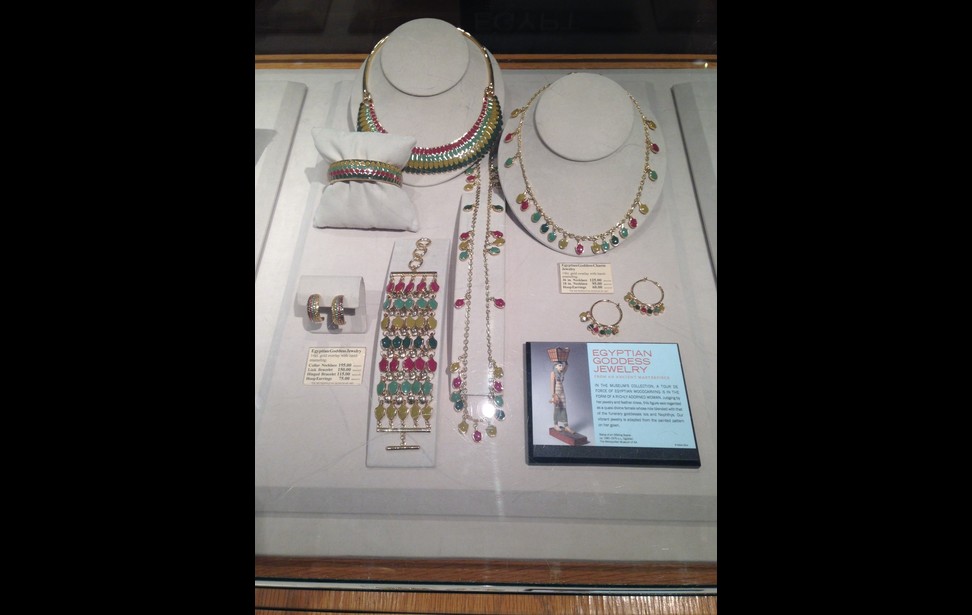The Art Inspired Designs of Sangeetha Kowsik
NEW YORK, NY - Imagine walking around one of the most famous museums in the world, being inspired by a piece of art, then making a scarf, or a necklace, or even a skateboard deck based on it. Now imagine this being your full-time job. Well, meet Sangeetha Kowsik. She is Senior Designer at The Metropolitan Museum of Art in New York, and the above is what she does for a living. Recently, she took me around the museum and showed me ancient Indian sculptures and taught me about different sculptural versions of the Buddha, for example. She also showed me what inspired many of her designs. One of Sangeetha's first pieces at her job was designing a set of jewelry – a brooch, cuff, pendant, earrings, and bracelet – based on the Art Nouveau Peacock (as seen in photo 1). The Egyptian Goddess pieces adopt the colors and interlinked shapes of the "Statue of an Offering Bearer" carved from wood over 2000 years ago (as seen in photos 2 and 3). All of her creations are on view, and for sale, in the Metropolitan Museum's gift shop (as seen in photo 4). But that is not the only place you can see her art-inspired designs. It's also all over her hands (literally). Each month, Sangeetha decorates her nails after being excited by a particular work of art (as seen in photo 5). In fact, she has a blog recording her handiwork, and you can follow here.
What follows are Sangeetha's generous answers to some questions I had about her life and work:
thalo: What drew you to design?
Sangeetha Kowsik: I grew up in a household surrounded by art. My father helped build two Hindu temples in the USA, so I was always surrounded by sculpture growing up. I was always sketching and drawing, since I was a child, but started to get formal training in painting when I was 13. In high school, I fell in love with Alexander McQueen's designs and wanted to attend design school and work for him. My parents would not let me attend Central St. Martins, so I went to Parsons instead. I have always loved colors, pigments, paints, makeup, sewing, and the beauty of nature, and being outside all aspects of design.
th: How would you describe the development of your training and career?
SK: I started at Parsons first in fashion design before switching to communication design. Being in communication design allowed me to explore other aspects of design such as printmaking, etching, and silk-screening, all of which I love. I also honed my skills in all the computer graphic programs such as the Adobe Creative Suite, took courses in web design, and learnt aftereffects. After Parsons, I worked for a hangtag and label manufacturer with a focus in branding and identity. I also worked for various publications doing graphic design work at Us Weekly. I worked extensively throughout the fashion industry for various houses doing graphics and design from low end to couture houses. Times were challenging during certain periods, but I feel by working on a variety of industries and companies I was able to hone my design skills even further. I am easily adaptable, for example, to an aesthetic of a company or brand.
th: What kind of strategies are unique to your work, developing unique products from pre-existing artworks in the Metropolitan Museum of Art?
SK: When I design, I have to always keep in mind what the art object in the Met's collection, or a design, was adapted from or inspired by. Sometimes I can take liberty with certain works of art (example creating a repeat pattern from a fabric swatch William Morris); other times it is a direct reproduction, say a piece of jewelry from the Egyptian department. I also I have to be careful in selecting images to use from the collection to ensure they don't offend anyone (e.g., no religious works of art unless it’s a Christmas card) and make sure that the historical and educational content of the original source object is captured in the design.
th: What are the challenges and rewards of the projects you work on?
SK: The challenge is how to make cool, innovative new product without compromising or changing an original piece of artwork in the Met's collection. The reward for me is that I am able to educate the public about important works of art in the Met's collection, important pieces that are of historical significance, and be able to open someone's eyes to something new through my design. Where else other than the Met would you see Egyptian Art, Mesopotamian Art, European Paintings, Asian Art, South Indian Art, Modern Art, Contemporary Art, Islamic Art, all housed under one roof?
th: If you had not become a designer, what would you be doing now?
SK: I don't know. I know that I have always loved to paint or draw. But probably an archeologist!
All photos courtesy of Rob Reed












